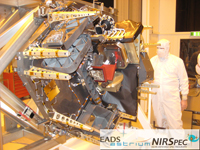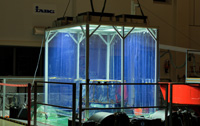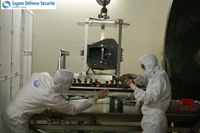NIRSpec Instrument Engineering Test Unit model is completed
14 October 2009
The Engineering Test Unit model of NIRSpec - the innovative and pioneering Near Infrared Spectrograph for the James Webb Space Telescope - has been completed by the prime contractor, EADS Astrium, and is ready to be shipped to NASA for testing.The James Webb Space Telescope (JWST) is a large (6.5 m), cold
 |
|
The NIRSpec Engineering Test Unit. Credit: EADS Astrium |
 |
|
The NIRSpec demonstration model during vibration tests. Credit: EADS Astrium |
The ETU will be shipped, later this year, to NASA's Goddard Space Flight Centre for pre-integration testing with the Integrated Science Instrument Module (ISIM), a key element of the JWST observatory which houses the four science instruments (NIRSpec, NIRCam, MIRI, and TFI), the associated electronics, and other components.
Progress on the NIRSpec flight model
 |
|
The NIRSpec camera optics during cryo testing at CSL, Belgium. Credit: Sagem Défense Sécurité |
In the meantime the NIRSpec flight model optical bench is beginning to take shape with integration and alignment activities for several flight model subsystems underway at Astrium since January this year.
A comprehensive test campaign for the complete flight model will begin mid-2010. In early 2011 the complete NIRSpec flight model is scheduled to be delivered to NASA for integration with the flight model ISIM.
Elements of the observatory begin to take shape
This year has seen a number of key elements of the JWST observatory pass significant milestones:
- September 2009: The flight model of the ISIM is delivered to GSFC for testing
- July 2009: The JWST spacecraft passes its Preliminary Design Review
- April 2009: The first of 18 flight mirrors completes cryogenic testing
- March 2009: The sunshield passes the Preliminary Design Review and moves to the detailed design phase
- February 2009: Construction of the telescope backplane begins
JWST and NIRSpec
The JWST observatory is a joint project of NASA, ESA and the Canadian Space Agency. It is scheduled to launch in 2014 and will carry four scientific instruments: NIRSpec (a near-infrared spectrograph), NIRCam (a near-infrared camera ), MIRI (a mid-infrared camera and spectrograph) and TFI (a tunable filter imager).
NIRSpec will be the principal spectrographic instrument on board the observatory. It is built by European industry to ESA's specifications and managed by the ESA JWST Project at ESTEC, the Netherlands. The prime contractor is EADS Astrium GmbH in Ottobrunn, Germany. The NIRSpec detector and Multi-Shutter Array subsystems are provided by NASA's Goddard Space Flight Center.
For more information:
Giorgio Bagnasco, ESA NIRSpec Instrument Manager
Science and Robotic Exploration Directorate, ESA, The Netherlands.
Email: Giorgio.Bagnasco esa.int; Phone: +31-71-565-8371
esa.int; Phone: +31-71-565-8371

